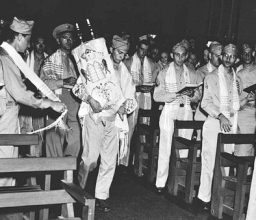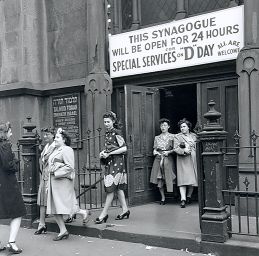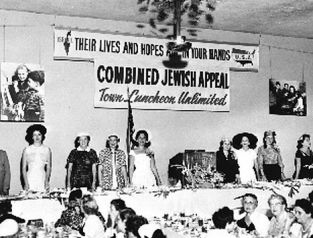from the National Humanities Center |
|
 | |
| NHC Home |
|
|
(Continued, part 2 of 2)
The American Jewish Experience in the Twentieth Century: Antisemitism and Assimilation by Jonathan D. Sarna and Jonathan GoldenAs World War II began, American Jewry presented a mixed picture. It was a community at home in America and proud of its achievements, but still uncertain of its identity or its position vis-à-vis other Jewish communities in the world. It faced substantial antisemitic hostility and discrimination, yet under President Franklin D. Roosevelt more Jews had entered public life than ever before. As Hitler's armies reduced European Jewish communities to ashes, the mantle of Jewish leadership firmly descended upon American Jewry. Yet its performance during these agonizing years—whether its leaders did enough to save their brethren in need—remains a subject of intense communal debate. Some blame Jewish leaders for not applying greater pressure
Shabbat (Sabbath) services
for Jewish airmen
Buckingham Army Air Field
Ft. Myers, 1944
Courtesy Florida State Archiveson their government and for failing to do more to rescue Jewish lives. Others sadly conclude that, given the realities of America's wartime priorities coupled with widespread domestic nativism and antisemitism, more could not have been done.
New York City, June 6, 1944
Library of CongressWith the terrible destruction of the major European centers of Judaism, America in 1945 stood unrivaled as the largest, richest, and politically most important Jewish community in the world. Smaller Jewish communities turned increasingly to American Jewry for guidance and support. Thousands of Jewish refugees likewise turned to America and under more liberal immigration policies many gained admission. Within a few years, some had contributed in vital ways to American cultural, scientific, and intellectual life. Others, especially Hungarian and Hassidic Jews (who emphasize strict allegiance to tradition),
added fresh dimensions to American Judaism, and helped to promote Orthodoxy's postwar revitalization.
Miami, 1950s
Banner: "Their Lives and Hopes
Are in Your Hands"
flanked by maps of Israel and the U.S.
Courtesy Florida State ArchivesWith its establishment in 1948, the State of Israel became the focal point of American Jewish life and philanthropy, as well as the symbol around which American Jews united. At the same time, American Jews worked in the years following World War II to reinvigorate American Jewish life. Five major themes defined the immediate postwar decades:
- the decline of antisemitism
- a massive movement of American Jews from cities to suburbs
- the emergence of an American Jewish communal order emphasizing Israel and political liberalism
- a large internal immigration of Jews to the American Sun Belt (particularly Los Angeles and Miami)
- glowing optimism concerning the American Jewish community and its future.
Burgeoning economic growth, increasing popular acceptance of religious and cultural pluralism, the high education achievements of native-born Jews, and an overpowering desire on the part of many Jews to "make it" in America all contributed during these decades to a spectacular rise of American Jews to positions of authority and respect within the general American community.
The Six-Day War of June 1967 marked a turning point in the lives of many 1960s-era Jews. The paralyzing fear of a "second Holocaust" followed by tiny Israel's seemingly miraculous victory over the combined Arab armies arrayed to destroy it struck deep emotional chords among American Jews. Their financial support for Israel rose sharply in the war's wake, and more of them than ever before chose in those years to make Israel their permanent home. In addition, something of a spiritual revival washed over the American Jewish community after 1967. Many turned religiously inward, some were "born again" into Orthodoxy, and every movement in American Judaism witnessed new interest in traditional religious practices, heightened appreciation for mystical and spiritual sources, and an enhanced desire for Jewish learning.
Two movements with far-reaching significance for American Jews emerged during this period, both of them influenced by America's domestic struggles for civil rights.
- The movement to save Soviet Jews.
American Jewish activists, in concert with Israel and with memories of the Holocaust fresh in their minds, waged a relentless "let my people go" campaign that ultimately proved successful. Hundreds of thousands of Soviet Jews subsequently emigrated to Israel and the United States.
Jewish women preparing for their adult Bat Mitzvah (confirmation)
Temple Ohev Sholem
Orlando, 1987
Courtesy Florida State Archives- Jewish feminism. This movement advocated gender equality and promoted increased involvement for women in all areas of Jewish life, including the synagogue. The ordination of women rabbis beginning in 1972, the burgeoning Jewish education opportunities opened to women, the development of women's rituals and prayer services, the emergence of women in many positions of communal responsibility once open only to men, and the changing role of women in Orthodoxy all attest to feminism's impact.
The waning days of the twentieth century found the American Jewish community at a crossroads in its history. Demographically, the community was stagnant. It had not grown appreciably since 1960, comprised a smaller percentage of America's total population than it had in 1920, and seemed likely to witness an actual decline in numbers in the decades ahead. The great issues of the past, including Zionism, no longer inspired and united American Jews as once they had. Nor was there any large community of suffering or persecuted Jews anywhere in the world calling upon the American Jewish community for assistance. As a result, American Jewry turned inward. Its new rallying cry, born of a survey that showed more Jews marrying out of their faith than within it, was "continuity."
Guiding Student Discussion
Mass migration of Jews and Catholics transformed American society and raised the question of what kind of nation America would become. Jews played an important role in shaping this debate and its terms.
- "The Melting Pot." The Anglo-Jewish writer, Israel Zangwill, in a play first produced in 1908 and dedicated to Theodore Roosevelt, attacked those who sought to fashion America on the European model and hailed instead the idea of "the melting pot," which was both the title of his play and the ideal to which he thought Americans should aspire ("Here shall they all unite to build the Republic of Man and the Kingdom of God").
- "Cultural Pluralism." By contrast, the American Jewish thinker Horace Kallen propounded what he called "cultural pluralism." He compared America to an orchestra, where each group played its own instrument while together they produced beautiful euphonic music.
Today, yet another model of American society has been propounded, the idea of "multiculturalism." What are the pros and cons of these different models? How have Jews and others sought to balance adaptation and retention? In what ways have they accommodated to America, and in what ways have they resisted it?
Zionism became a central theme of American Jewish life in the years between the world wars. Louis Brandeis, who became the leader of American Zionism on the eve of World War I, just prior to his becoming the first Jew to serve on the U.S. Supreme Court, did much to make it fashionable, linking Zionism to "the American ideal of democracy, of social justice and of liberty," and arguing that "to be good Americans we must be better Jews, and to be better Jews, we must become Zionists." Opponents of Zionism, meanwhile, argued that Jews should strive to be accepted as full and equal citizens of the countries where they lived, and they feared that Zionism would raise the specter of dual loyalty. Where Zionists stressed that Jews were primarily a people who needed a homeland, anti-Zionists insisted that Judaism was primarily a religion that Jews should be free to practice anywhere in the world. Looking back, how do students evaluate this debate? Why did it arise during the interwar years, and which arguments, in retrospect, seem more persuasive?
Historians Debate
Historians have long debated both the extent of antisemitism in America's past, and the similarities and
differences between American antisemitism and its European counterpart. Earlier students of American Jewish life minimized antisemitism, which they viewed as a late and alien phenomenon on the American scene arising in the late nineteenth century. More recently, scholars have pushed back the history of American antisemitism, discovering that no period in American Jewish history was free of this scourge: Jews encountered it from their earliest days on American soil. Yet the significance of antisemitism at different times, and the distinctiveness of the American encounter with the "great hatred," remain subjects of intense debate; see Leonard Dinnerstein, Antisemitism in America (1994), David Gerber, Anti-Semitism in American History (1986), and John Higham, Send These to Me: Jews and Other Immigrants in America (1975).
Antisemitic vandalism at a
Hebrew day school (no date)
Courtesy Florida State ArchivesAn even more contentious debate revolves around the role of American Jews in the Holocaust and whether they might have done more to save their fellow Jews from the Nazis and their accomplices. For different perspectives, see David Wyman, The Abandonment of the Jews (1984) and Henry Feingold, Bearing Witness: How America and Its Jews Responded to the Holocaust (1995).
Two textbooks, Arthur Hertzberg, The Jews in America: Four Centuries of an Uneasy Encounter (1990) and Howard M. Sachar, A History of the Jews in America (1992), contain significant sections on twentieth-century American Jewry, while Jonathan D. Sarna's reader, The American Jewish Experience (2d. ed., 1997), makes available interpretive articles and bibliographies. Henry Feingold, A Time for Searching: Entering the Mainstream, 1920-1945 (1992) and Beth Wenger, New York Jews and the Great Depression (1996) deal with the interwar years. For accounts of postwar American Jewry, see Edward Shapiro, A Time for Healing: American Jewry Since World War II (1992), Samuel Heilman, Portrait of American Jews: The Last Half of the 20th Century (1995), and Jack Wertheimer, A People Divided: Judaism in Contemporary America (1993).
Links to online resources
List of works cited in this essay
Jonathan Sarna is the Joseph H. & Belle R. Braun Professor of American Jewish History in the Department of Near Eastern and Judaic Studies at Brandeis University. In addition to his publications cited in this essay, he is the co-editor of Minority Faiths and the Protestant Mainstream (University of Illinois Press, 1997) and The Jews of Boston (1995). He edits Brandeis Studies in American Jewish History, Culture and Life with the University Press of New England, and co-edits the American Jewish Civilization Series at Wayne State University Press. He is currently writing a new history of American Judaism to be published by Yale University Press.
Jonathan Golden is a research and teaching assistant with Professor Sarna at Brandeis University and also a teaching assistant with Professor Jay Harris at Harvard University. He holds an M.A. in Jewish education from Hebrew College in Boston. He recently co-authored an article with Professor Sarna on noteworthy events in Judaism in 1998 for the 1999 World Book Year Book. Address comments or questions to Professor Sarna and Mr. Golden through TeacherServe "Comments and Questions."
| Religious Liberalism and the Modern Crisis of Faith | The Rise of Fundamentalism | The Scopes Trial | Marcus Garvey | Roman Catholics and the American Mainstream | American Jewish Experience in the 20th Century | Islam in America | Religion in Post-World-War II America | The Christian Right | 20th-Century Links |
TeacherServe Home Page
National Humanities Center Home Page
Revised: October 2000
nationalhumanitiescenter.org




